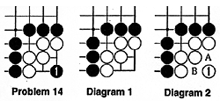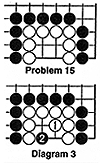Lee Chang Ho, undisputed world go champion
There are four annual tournaments that bill themselves as world championships: Samsung Cup, LG Cup, Fujitsu Cup, and around Tong Yang Securities Cup. Every year, top players from around the world head for South Korea or Japan to compete for hundreds of thousands of dollars in prize money.These are all elimination tournaments, so the odds are quite high against any one player making it to all four finals. However, over the past year, South Korean superstar Lee Chang Ho not only managed to get into the finals of all four tournaments, he also managed to win three of them, and is on the verge of triumphing in the fourth.
Lee is now 23 years old, but he has been a force to be reckoned with in the go world for the last seven years. Since he was 16, he has dominated all the South Korean titles, and he has also taken his share of international titles. However, it will be a major achievement should he make a clean sweep of all the world cup championships this year.
Lee's odyssey began last April when he reached the best-of-five final of the 9th Tong Yang Securities Cup. His opponent was compatriot Yoo Chang Hyuk, a regular contender in the finals of these international tournaments. Lee won the match 3-1, making it the fourth time he has won this tournament.
Then during the spring and autumn, Lee won his way to the final round of the 11th Fujitsu Cup. There, he faced another superstar, top Chinese player Chang Hao, who is only 22 years old. After a titanic struggle worthy of these two young geniuses, Lee managed to win the game by a mere 11/2 points. This was the second time for Lee to win this championship.
In the best-of-five Samsung Cup final, held in early February, Lee faced Ma Xiaochun, China's No. 2 player. The match was closely contested with both players splitting the first four games, but Lee managed to eke out a 21/2 point win in the fifth and final game. This was the second year in a row that Lee has won this most prestigious of the world championships, which has a first prize of more than $300,000.
Lee and Ma are facing each other again in the 3rd LG Cup. This is also a best-of-five final. The first two games were held on March 2 and 3, with Lee winning both of them. A two-game lead in a best-of-five match is a difficult handicap for anyone to overcome against Lee, so it seems quite likely that he will prevail in this tournament as well, making a clean sweep of all the world championship go tournaments over the last year.
Lee will no doubt be busy over the next year or so. China founded a new international tournament at the end of past year called the Spring Orchid Cup. The first two rounds were held in late December and Lee made it to the quarterfinals, which will be held sometime this month.
Answers to last week's problems
 Problem 14. This is another example of a bent three-point eye space. The key point for the life or death of the white stones is at Black 1 in Diagram 1. If Black plays here, White cannot make two eyes. On the other hand, if White is able to play at this key point in Diagram 2, his stones are alive because he can make two eyes: at A and B.
Problem 14. This is another example of a bent three-point eye space. The key point for the life or death of the white stones is at Black 1 in Diagram 1. If Black plays here, White cannot make two eyes. On the other hand, if White is able to play at this key point in Diagram 2, his stones are alive because he can make two eyes: at A and B.
 Problem 15. The white stones form a square four-point eye space and they cannot make two eyes, even if it is White's turn to move. For example, if White plays 1 (Diagram 3) , his stones will form a three-point eye space similar to the one in Problem 14. It is now Black's turn, so he can play at 2 and White cannot make two eyes. Note that the position is symmetrical, so wherever White plays his first move, he will always end up with a three-point eye space.
Problem 15. The white stones form a square four-point eye space and they cannot make two eyes, even if it is White's turn to move. For example, if White plays 1 (Diagram 3) , his stones will form a three-point eye space similar to the one in Problem 14. It is now Black's turn, so he can play at 2 and White cannot make two eyes. Note that the position is symmetrical, so wherever White plays his first move, he will always end up with a three-point eye space.
 Problem 16. In this straight four-point eye space, the white stones have enough space to make two eyes without White doing anything. If Black plays 1 (Diagram 4), White plays 2, and he has two eyes: one on the right and one on the left. If Black plays at 2 instead, White will defend at 1. Note that White must answer Black 1. If he ignores Black's move, Black will play 3 in Diagram 5 and White will be unable to make two eyes.
Problem 16. In this straight four-point eye space, the white stones have enough space to make two eyes without White doing anything. If Black plays 1 (Diagram 4), White plays 2, and he has two eyes: one on the right and one on the left. If Black plays at 2 instead, White will defend at 1. Note that White must answer Black 1. If he ignores Black's move, Black will play 3 in Diagram 5 and White will be unable to make two eyes.
 Problem 17. The white stones here form a bent four-point eye space. As in Problem 16, they are alive as they stand. If Black plays 1 in Diagram 6, White gets two eyes by playing at 2. If Black 1 at 2, White will play at 1. Again, White must answer Black 1 with 2. If Black can play at both 1 and 2, the White stones will be unable to make two eyes and they will die.
Problem 17. The white stones here form a bent four-point eye space. As in Problem 16, they are alive as they stand. If Black plays 1 in Diagram 6, White gets two eyes by playing at 2. If Black 1 at 2, White will play at 1. Again, White must answer Black 1 with 2. If Black can play at both 1 and 2, the White stones will be unable to make two eyes and they will die.
 Problem 18. In this pyramidal four-point eye space, White 1 in Diagram 7 is the key point; White has made three eyes. If Black gets to play 1 in Diagram 8, White is reduced to one big eye space and cannot make two eyes.
Problem 18. In this pyramidal four-point eye space, White 1 in Diagram 7 is the key point; White has made three eyes. If Black gets to play 1 in Diagram 8, White is reduced to one big eye space and cannot make two eyes.
 Problem 19. The white stones form a five-point eye space. White must play 1 (or A) in Diagram 9. Either way, he has two eyes. If Black gets to play on the key point with 1 in Diagram 10, White cannot make two eyes and his stones will die. If White plays 2, Black will play 3.
Problem 19. The white stones form a five-point eye space. White must play 1 (or A) in Diagram 9. Either way, he has two eyes. If Black gets to play on the key point with 1 in Diagram 10, White cannot make two eyes and his stones will die. If White plays 2, Black will play 3.
